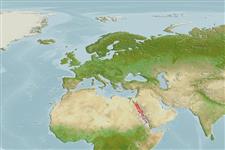Environment: milieu / climate zone / depth range / distribution range
Ecologie
marien bathydemersaal; diepte 750 - 1425 m (Ref. 9942). Deep-water
Western Indian Ocean: endemic to the Red Sea. Gene flow between the Red Sea and the Gulf of Aden can be excluded.
Grootte / Gewicht / Leeftijd
Maturity: Lm ? range ? - ? cm
Larvae do not seem to live in shallow water.
Levenscyclus en paargedrag
Maturities | Voortplanting | Spawnings | Egg(s) | Fecundities | Larven
Klausewitz, W., 1994. Comparative studies on the vertical distribution of bathybenthic deep-sea fishes of the Red Sea. Proc. IPFC 4:462-468. (Ref. 9942)
Status op de Rode Lijst van het IUCN (Ref. 130435)
Gevaar voor de mens
Harmless
Gebruik door de mens
Tools
Speciale rapporten
Download XML
Internetbronnen
Estimates based on models
Preferred temperature (Ref.
123201): 21.6 - 21.8, mean 21.7 °C (based on 7 cells).
Fylogenetische diversiteitsindex (Ref.
82804): PD
50 = 0.5001 [Uniqueness, from 0.5 = low to 2.0 = high].
Bayesian length-weight: a=0.00102 (0.00046 - 0.00225), b=3.06 (2.88 - 3.24), in cm total length, based on all LWR estimates for this body shape (Ref.
93245).
Trofisch niveau (Ref.
69278): 3.8 ±0.3 se; based on size and trophs of closest relatives
Fishing Vulnerability (Ref.
59153): Low vulnerability (23 of 100).
